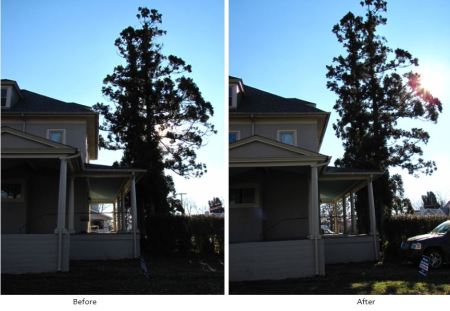Back in October, we were at a client’s property in Oaks, PA to do some tree pruning when I noticed something odd.
A surface root from one of her trees had been chopped at with an axe where it grew onto the neighbor’s property. Nothing unusual there, I’m used to seeing roots cut by people who object to their presence on the lawn surface. But there were several little white balls lying on and around the cut root. What were they? They looked like moth balls. I picked one up and smelled it. Chlorine. Someone had spilled a little pile of pool chemical tablets. Then I noticed something else: two pieces of copper tubing had been hammered into the root. THAT wasn’t an accident.


The chopped root
I’ve often heard people recite the old wives tale that if you want to kill a tree, drive copper nails into it. (Copper sulfate DOES have herbicidal properties, but this trick will not work). So, what’s going on here? Axe cuts, pool chemicals, copper – sure looks like someone doesn’t like this tree!
Looking at the tree itself, the leaves on the side closest to the neighbor were curled at the edges, dry and scorched looking.

I don’t think it’s at all unlikely that the pool chemicals could be responsible for this leaf scorch, especially if it is one of the many formulations that contain an algaecide.
I shared my suspicions with the client. She is brand new in the neighborhood, and hasn’t even met the neighbor yet. I suggested that she let us prune the maximum practical amount where the tree’s branches hung near the neighbor’s pool. Better not to give him reason to complain. And it seems nobody likes trees too close to a pool.
Of course, I can’t prove the neighbor intentionally tried to poison the tree. But later in the day while the climbers were in the tree pruning it, they were discussing the symptoms they were seeing. Unknown to them, the neighbor had walked over and was listening in on their conversation. Overhearing them speculate on the likelihood of cause and effect, he announced his presence by yelling “Yeah, yeah buddy, whatever you say.” And then, in a very hostile tone, he denied involvement and rambled on until the men became quite tired of listening.
If indeed this was an intentional tree poisoning, it’s not the first one I’ve seen. Probably the most scary was a few years ago, in Worcester. My client suspected his neighbor of sneaking onto his property and drilling large holes in the tree trunks and dosing them with Roundup herbicide. (Lab tests confirmed the herbicide). Not everybody is a tree lover.
Back to the story – the client in Oaks knows to be vigilant. And the neighbor knows he’s a suspect. I sure hope they end up getting to know one another and become friends!
Click here to read another tree poisoning story, this one in Seattle, Washington.







